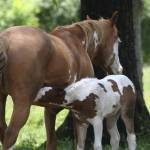Benefits of Mare Colostrum: Beyond Antibodies

The importance of colostrum to a foal’s livelihood is widely highlighted in the equine literature and media. Foals require a sufficient volume of high-quality colostrum within the first hours of life because they lack infection-fighting antibodies at birth.
According to researchers from The Netherlands*, there are a multitude of other benefits to colostrum. For example, did you know these facts?
- Milk and colostrum contain a specific carbohydrate called “milk oligosaccharides,” which are short chains of sugars bonded together. In horses they are abbreviated as EMOS.
- EMOS are thought to promote the growth of bifidobacteria, a type of probiotic that enhances the health of the gastrointestinal tract.
“In addition, bifidobacteria can ferment oligosaccharides, creating short-chain fatty acids that decrease the pH of the intestine, which helps prevent the growth of disease-causing microorganisms,” adds Peter Huntington, B.V.Sc., M.A.C.V.Sc., director of nutrition at Kentucky Equine Research (Australia).
- EMOS are also believed to have direct immunomodulating properties, meaning that they are capable of helping the immune system fight infection.
- Finally, EMOS serve as “soluble ligands” for bacteria, viruses, and other disease-causing microorganisms. This means that the microbes are tricked into binding to the EMOS instead of the wall of the intestinal tract, where they can cause disease.
Just as colostrum quality, including protein levels, varies among individual horses and horse breeds, EMOS also differ in terms of both quantity and type of sugars that make up the EMOS.
“This is an exciting, emerging field of research that could identify additional bioactive effects of milk and colostrum that ultimately benefit foals. It reminds us how vital colostrum is for the foal and why breeders must ensure the foal gets enough colostrum,” concludes Huntington.
*Difilippo, E., H.A. Willems, J.C. Vendrig, et al. 2015. Comparison of milk oligosaccharides pattern in colostrum of different horse breeds. Journal of Agriculture and Food Chemistry 63(19):4805–4814.








